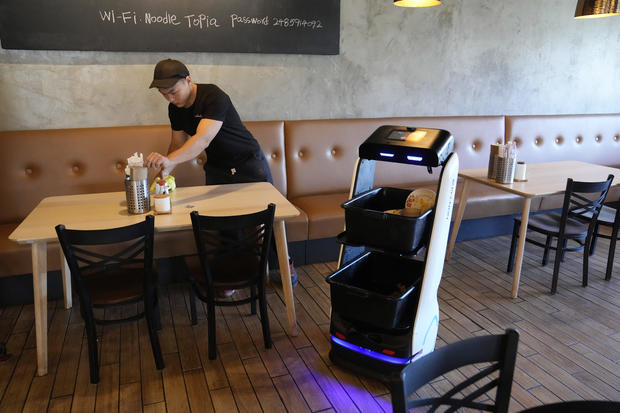You may have already seen them in restaurants: waist-high machines that can greet guests, lead them to their tables, deliver food and drinks and ferry dirty dishes to the kitchen. Some have cat-like faces and even purr when you scratch their heads.
But are robot waiters the future? It’s a question the restaurant industry is increasingly trying to answer.
Many think robot waiters are the solution to the industry’s labor shortages. Sales of them have been growing rapidly in recent years, with tens of thousands now gliding through dining rooms worldwide.
“There’s no doubt in my mind that this is where the world is going,” said Dennis Reynolds, dean of the Hilton College of Global Hospitality Leadership at the University of Houston. The school’s restaurant began using a robot in December, and Reynolds says it has eased the workload for human staff and made service more efficient.
But others say robot waiters aren’t much more than a gimmick that have a long way to go before they can replace humans. They can’t take orders, and many restaurants have steps, outdoor patios and other physical challenges they can’t adapt to.
“Restaurants are pretty chaotic places, so it’s very hard to insert automation in a way that is really productive,” said Craig Le Clair, a vice president with the consulting company Forrester who studies automation.
Carlos Osorio / AP
Tens of thousands deployed worldwide
Still, the robots are proliferating. Redwood City, California-based Bear Robotics introduced its Servi robot in 2021 and expects to have 10,000 deployed by the end of this year in 44 U.S. states and overseas. Shenzen, China-based Pudu Robotics, which was founded in 2016, has deployed more than 56,000 robots worldwide.
“Every restaurant chain is looking toward as much automation as possible,” said Phil Zheng of Richtech Robotics, an Austin-based maker of robot servers. “People are going to see these everywhere in the next year or two.”
Li Zhai was having trouble finding staff for Noodle Topia, his Madison Heights, Michigan, restaurant, in the summer of 2021, so he bought a BellaBot from Pudu Robotics. The robot was so successful he added two more. Now, one robot leads diners to their seats while another delivers bowls of steaming noodles to tables. Employees pile dirty dishes onto a third robot to shuttle back to the kitchen.
The robots also save him money. Zhai now only needs three people to do the same volume of business that five or six people used to handle. While a robot costs around $15,000, he said, a person costs $5,000 to $6,000 per month.
More time to mingle
Zhai said the robots give human servers more time to mingle with customers, which increases tips. And customers often post videos of the robots on social media that entice others to visit.
“Besides saving labor, the robots generate business,” he said.
Interactions with human servers can vary. Betzy Giron Reynosa, who works with a BellaBot at The Sushi Factory in West Melbourne, Florida, said the robot can be a pain.
“You can’t really tell it to move or anything,” she said. She has also had customers who don’t want to interact with it.
But overall the robot is a plus, she said. It saves her trips back and forth to the kitchen and gives her more time with customers.
Labor shortages accelerated the adoption of robots globally, Le Clair said. In the U.S., the restaurant industry employed 15 million people at the end of last year, but that was still 400,000 fewer than before the pandemic, according to the National Restaurant Association. In a recent survey, 62% of restaurant operators told the association they don’t have enough employees to meet customer demand.
Acceptance boosted by pandemic
Pandemic-era concerns about hygiene and adoption of new technology like QR code menus also laid the ground for robots, said Karthik Namasivayam, director of hospitality business at Michigan State University’s Broad College of Business.
“Once an operator begins to understand and work with one technology, other technologies become less daunting and will be much more readily accepted as we go forward,” he said.
Namasivayam notes that public acceptance of robot servers is already high in Asia. Pizza Hut has robot servers in 1,000 restaurants in China, for example.
The U.S. was slower to adopt robots, but some chains are now testing them. Chick-fil-A is trying them at multiple U.S. locations, and says it’s found that the robots give human employees more time to refresh drinks, clear tables and greet guests.
Carlos Osorio / AP
Marcus Merritt was surprised to see a robot server at a Chick-fil-A in Atlanta recently. The robot didn’t seem to be replacing staff, he said; he counted 13 employees in the store, and workers told him the robot helps service move a little faster. He was delighted that the robot told him to have a great day, and expects he’ll see more robots when he goes out to eat.
“I think technology is part of our normal everyday now. Everybody has a cellphone, everybody uses some form of computer,” said Merritt, who owns a marketing business. “It’s a natural progression.”
“The machine can never replace humans”
But not all chains have had success with robots.
Chili’s introduced a robot server named Rita in 2020 and expanded the test to 61 U.S. restaurants before abruptly halting it last August. The chain found that Rita moved too slowly and got in the way of human servers. And 58% of guests surveyed said Rita didn’t improve their overall experience.
Haidilao, a hot pot chain in China, began using robots a year ago to deliver food to diners’ tables. But managers at several outlets said the robots haven’t proved as reliable or cost-effective as human servers.
Wang Long, the manager of a Beijing outlet, said his two robots have both broken down.
“We only used them now and then,” Wang said. “It is a sort of concept thing and the machine can never replace humans.”
Human service a premium?
Eventually, Namasivayam expects that a certain percentage of restaurants — maybe 30% — will continue to have human servers and be considered more luxurious, while the rest will lean more heavily on robots in the kitchen and in dining rooms. Economics are on the side of robots, he said; the cost of human labor will continue to rise, but technology costs will fall.
But that’s not a future everyone wants to see. Saru Jayaraman, who advocates for higher pay for restaurant workers as president of One Fair Wage, said restaurants could easily solve their labor shortages if they just paid workers more.
“Humans don’t go to a full-service restaurant to be served by technology,” she said. “They go for the experience of themselves and the people they care about being served by a human.”

















































